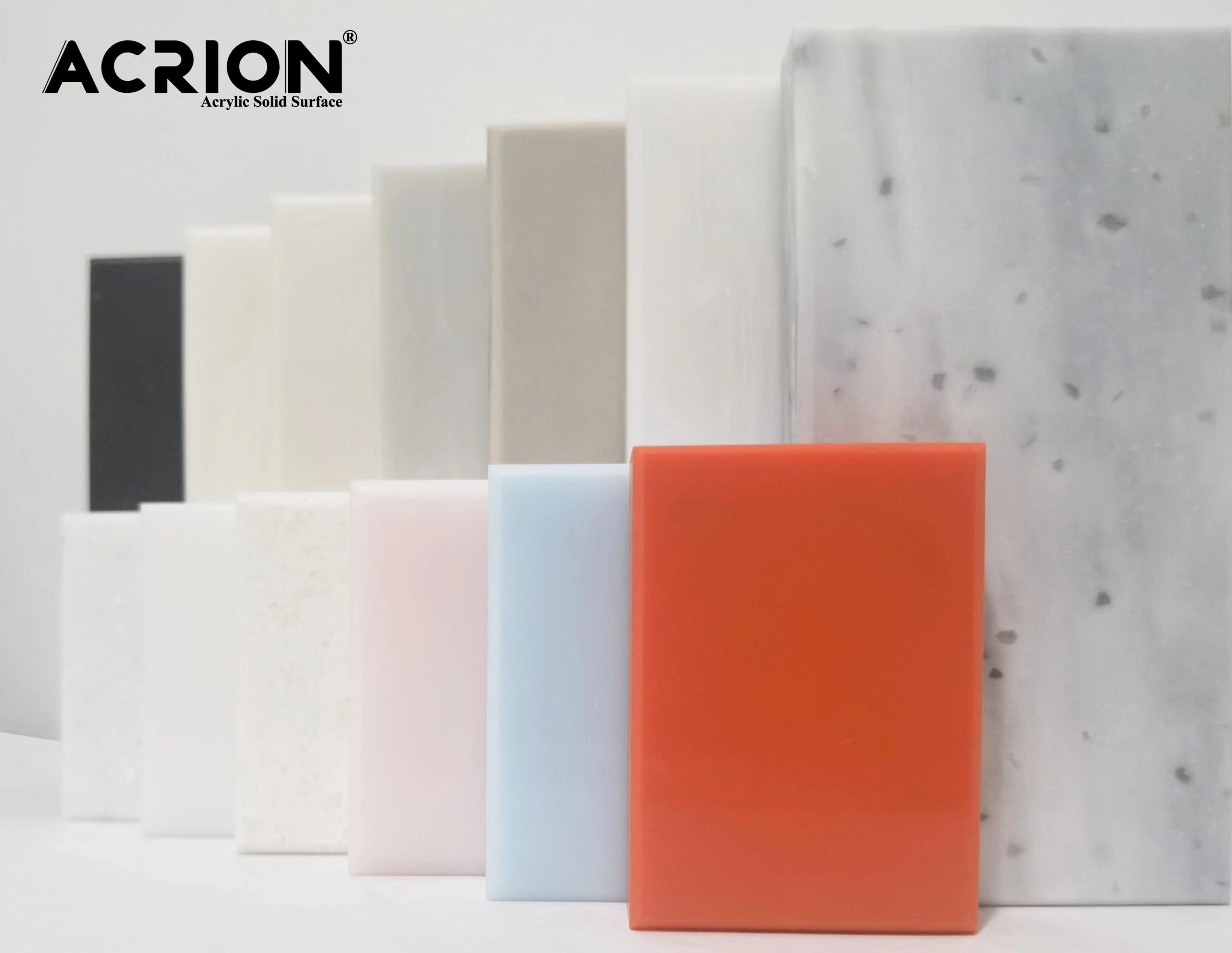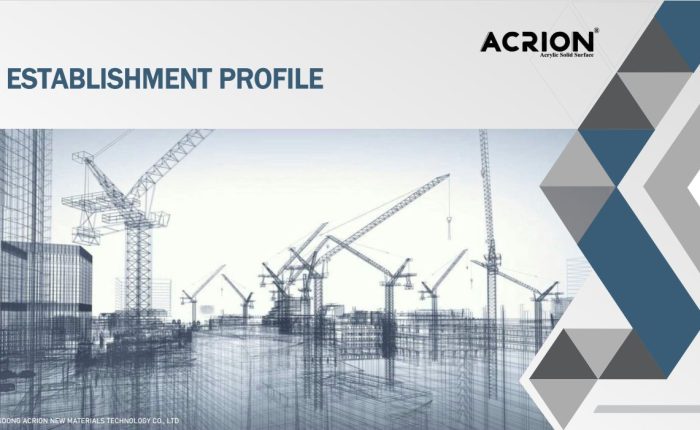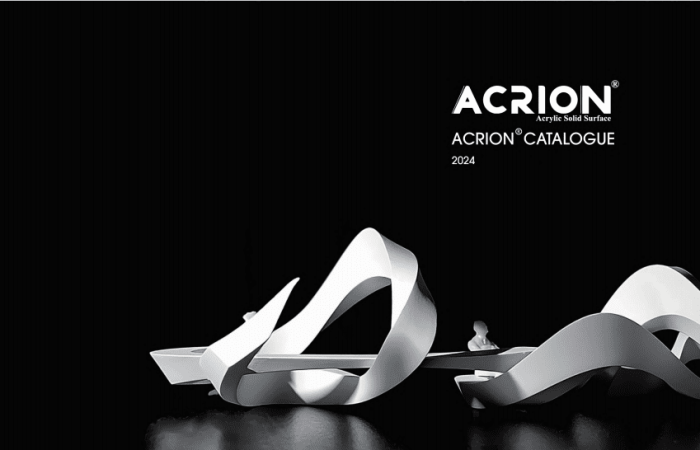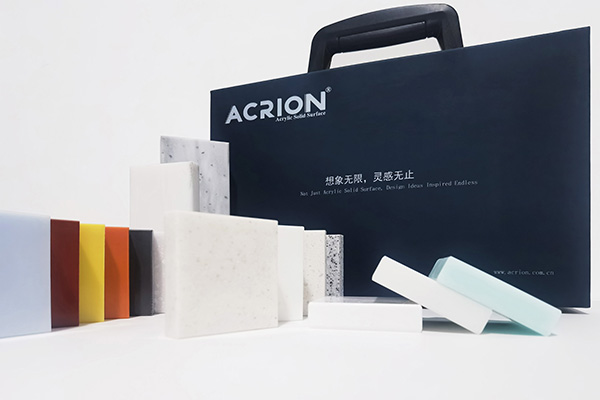Mẹo bảo trì thiết yếu cho mặt bàn Acrion: Những cân nhắc chính cho tuổi thọ và tỏa sáng
Mặt bàn ACRION là một lựa chọn phổ biến cho vẻ ngoài liền mạch, độ bền và tính linh hoạt của chúng. Tuy nhiên, giống như bất kỳ bề mặt chất lượng cao nào, họ cần được chăm sóc đúng cách để duy trì sự hấp dẫn thẩm mỹ và tính toàn vẹn cấu trúc của họ theo thời gian. Cho dù được lắp đặt trong nhà bếp, phòng tắm hoặc các khu vực giao thông cao khác, hiểu được nhu cầu bảo trì cụ thể của Acrion là rất quan trọng. Hướng dẫn này phác thảo những cân nhắc quan trọng để giúp bạn bảo tồn vẻ đẹp và chức năng của bạn trong nhiều năm tới.
Thực hành làm sạch hàng ngày để ngăn ngừa thiệt hại
Quản lý sự cố tràn ngay lập tức
Một trong những khía cạnh quan trọng nhất của bảo trì Acrion là giải quyết sự cố tràn kịp thời. Các chất lỏng như rượu vang, cà phê hoặc các chất có tính axit như nước cam quýt có thể xâm nhập vào bề mặt nếu không được giám sát, dẫn đến vết bẩn cứng đầu. Sử dụng một miếng vải mềm, hấp thụ để làm đổ ngay khi chúng xảy ra, tránh các chuyển động cọ xát có thể lan truyền chất lỏng hoặc nhúng nó vào sâu hơn vào vật liệu. Đối với dư lượng dính, làm ẩm vải với nước ấm và xà phòng nhẹ, không hấp thụ trước khi lau.
Công cụ và giải pháp làm sạch nhẹ nhàng
Tránh sử dụng miếng đệm chà khắc nghiệt, len thép hoặc chất tẩy rửa mài mòn trên bề mặt Acrion, vì chúng có thể làm trầy xước hoặc làm mờ kết thúc. Thay vào đó, hãy chọn một miếng bọt biển mềm, vải microfiber hoặc miếng làm sạch không hấp thụ. Khi chọn một giải pháp làm sạch, chọn một sản phẩm trung tính pH, không hấp thụ được thiết kế cho các bề mặt rắn. Ngoài ra, một hỗn hợp đơn giản của nước ấm và xà phòng rửa chén nhẹ thường đủ để làm sạch hàng ngày. Rửa kỹ bằng nước sạch sau khi làm sạch để loại bỏ bất kỳ dư lượng xà phòng.
Làm khô bề mặt sau khi làm sạch
Các đốm nước và vệt có thể làm mất đi sự xuất hiện bóng bẩy của mặt bàn. Sau khi làm sạch, sử dụng một miếng vải khô, không có xơ để làm khô hoàn toàn bề mặt. Bước này đặc biệt quan trọng trong các khu vực có nước cứng, vì các mỏ khoáng có thể để lại dấu hiệu khó coi theo thời gian. Hãy chú ý thêm đến các đường nối và các cạnh nơi nước có thể tích tụ.
Tránh những cạm bẫy phổ biến gây hao mòn
Các biện pháp bảo vệ nhiệt
ACRION có khả năng chịu nhiệt nhưng không chống nhiệt. Tiếp xúc kéo dài với nhiệt độ cao có thể gây đổi màu, cong vênh hoặc thậm chí nứt. Luôn luôn sử dụng Trivets, miếng đệm nóng hoặc thảm cách điện dưới nồi nóng, chảo và các thiết bị như nồi nấu chậm hoặc chảo điện. Tránh đặt các vật phẩm nóng trực tiếp lên mặt bàn, ngay cả trong những khoảnh khắc ngắn, vì thay đổi nhiệt độ đột ngột có thể làm hỏng vật liệu.
Ngăn chặn vết trầy xước và vết cắt
Trong khi Acrion tương đối chống trầy xước, các vật sắc nhọn như dao hoặc dụng cụ gốm có thể để lại dấu hiệu nếu được sử dụng trực tiếp trên bề mặt. Luôn luôn sử dụng các bảng cắt khi chuẩn bị thức ăn, và tránh kéo các vật nặng hoặc sắc nét trên mặt bàn. Nếu các vết trầy xước xuất hiện, chúng thường có thể được đệm bằng giấy nhám mịn (1200 grit hoặc cao hơn) sau đó đánh bóng bằng vải mềm và hợp chất mài mòn nhẹ. Tuy nhiên, phòng ngừa luôn tốt hơn sửa chữa.
Rủi ro tiếp xúc hóa học
Một số hóa chất gia đình có thể làm hỏng bề mặt acrion. Tránh sử dụng các dung môi như chất làm loãng sơn, acetone hoặc tẩy sơn móng tay, vì chúng có thể hòa tan hoặc làm mất màu vật liệu. Tương tự, tránh chất tẩy rửa mài mòn có chứa thuốc tẩy, amoniac hoặc chất tẩy rửa lò, vì chúng có thể khắc bề mặt và khiến nó trông xỉn màu. Nếu bạn cần loại bỏ các vết bẩn hoặc chất kết dính cứng đầu, trước tiên hãy kiểm tra bất kỳ sản phẩm làm sạch nào trên khu vực không rõ ràng và làm theo hướng dẫn của nhà sản xuất một cách cẩn thận.
Chiến lược chăm sóc dài hạn cho vẻ đẹp lâu dài
Đánh bóng thường xuyên để khôi phục độ bóng
Theo thời gian, mặt bàn Acrion có thể mất ánh sáng do hao mòn hàng ngày. Đánh bóng bề mặt cứ sau vài tháng có thể giúp khôi phục độ bóng ban đầu của nó và tạo ra một rào cản bảo vệ chống lại thiệt hại trong tương lai. Sử dụng một hợp chất đánh bóng chất lượng cao được thiết kế dành riêng cho các bề mặt rắn, áp dụng nó theo chuyển động nhỏ, hình tròn với vải mềm hoặc miếng đánh bóng. Thực hiện theo các hướng dẫn sản phẩm để có kết quả tốt nhất và tránh đánh giá quá cao, vì điều này có thể tạo ra sự tích tụ sáp.
Kiểm tra và bảo trì đường may
Mặt bàn ACRION thường được nối với các đường nối hầu như vô hình khi được cài đặt đúng cách. Tuy nhiên, các đường nối này có thể trở nên đáng chú ý hơn theo thời gian do dịch chuyển hoặc mặc. Thường xuyên kiểm tra các đường nối để biết các dấu hiệu tách hoặc nứt, đặc biệt là ở các khu vực giao thông cao hoặc gần bồn rửa và đầu bếp. Nếu bạn nhận thấy bất kỳ vấn đề nào, hãy liên hệ với Trình cài đặt chuyên nghiệp để đánh giá và sửa chữa các đường nối trước khi chúng trở nên tồi tệ hơn.
Giải quyết sự đổi màu và mờ dần
Tiếp xúc kéo dài với ánh sáng mặt trời trực tiếp có thể khiến các bề mặt Acrion bị phai hoặc vàng theo thời gian, đặc biệt là ở các khu vực gần cửa sổ hoặc dưới giếng trời. Để giảm thiểu rủi ro này, hãy sử dụng các phương pháp điều trị cửa sổ như rèm hoặc rèm cửa để chặn ánh sáng mặt trời khắc nghiệt trong giờ cao điểm. Nếu sự đổi màu xảy ra, hãy tham khảo ý kiến một người tinh chế chuyên nghiệp chuyên về bề mặt Acrion. Họ có thể khôi phục màu sắc ban đầu bằng các kỹ thuật và sản phẩm chuyên dụng.
Xử lý các vết bẩn cụ thể và thiệt hại hiệu quả
Vết mực và thuốc nhuộm
Mực từ bút, điểm đánh dấu hoặc báo chí có thể để lại vết bẩn khó coi trên bề mặt acrion. Để loại bỏ những vết bẩn này, làm giảm một miếng vải mềm bằng rượu cọ xát (rượu isopropyl) và nhẹ nhàng làm mờ vùng bị ảnh hưởng. Tránh cọ xát, vì điều này có thể lan truyền vết bẩn. Rửa sạch khu vực với nước và khô hoàn toàn. Đối với các vết mực cứng đầu, hãy lặp lại quy trình hoặc tham khảo ý kiến chất tẩy rửa chuyên nghiệp.
Vết bẩn nước và tiền gửi khoáng sản
Nước cứng có thể để lại các đốm nhiều mây hoặc mỏ khoáng trên mặt bàn, đặc biệt là xung quanh các bồn rửa và vòi. Để loại bỏ các vết bẩn này, hãy tạo một hỗn hợp bằng cách sử dụng baking soda và nước và áp dụng nó vào khu vực bị ảnh hưởng. Hãy để nó ngồi trong 15-20 phút, sau đó chà nhẹ với một miếng bọt biển hoặc vải mềm. Rửa kỹ với nước và khô. Để tích tụ khoáng chất nghiêm trọng, bạn có thể cần sử dụng chất tẩy vôi thương mại được thiết kế cho các bề mặt rắn, theo hướng dẫn sản phẩm một cách cẩn thận.
Vết trầy xước sâu
Trong khi Acrion là bền, các vết trầy xước hoặc gouges sâu có thể xảy ra từ các tác động tình cờ hoặc sử dụng nặng. Đối với các vết xước nhỏ, hãy làm theo các bước chà nhám và đánh bóng được phác thảo trước đó. Để có thiệt hại sâu sắc hơn, tốt nhất là bạn nên tham khảo ý kiến người hoàn thiện chuyên nghiệp, người có thể đánh giá mức độ thiệt hại và đề xuất phương pháp sửa chữa thích hợp. Trong một số trường hợp, khu vực bị ảnh hưởng có thể cần phải được lấp đầy và xuất hiện trở lại để khôi phục một kết thúc liền mạch.
Bằng cách làm theo các mẹo bảo trì toàn diện này, bạn có thể đảm bảo mặt bàn Acrion của bạn vẫn là một trung tâm đẹp và chức năng trong nhà của bạn trong nhiều năm. Chăm sóc nhất quán, kết hợp với sự hiểu biết về các tài sản độc đáo của vật liệu, sẽ giúp bạn tránh những cạm bẫy thông thường và tận hưởng những lợi ích của bề mặt linh hoạt này.



